Did Eadweard J. Muybridge get away with murder?
Loading...
Photographer Eadweard J. Muybridge is renowned for his frame-by-frame snapshots of a galloping horse, celebrated on Monday with a special Google doodle in his honor. The famous reel, taken in the late 1870s, proved that at the height of a horse’s gallop, all four of its legs are in the air. But Muybridge had an entirely different reputation in 1874 – that of a cold-blooded killer.
Muybridge married the 21-year-old Flora Stone in 1872. They had a baby boy, Floredo Helios Muybridge, two years later. But Muybridge thought Floredo might not have been his son. He discovered a series of letters between his wife and drama critic Major Harry Larkyns, according to Stanford Magazine. She even sent a picture of Floredo to Larkyns with the caption “Little Harry.”
Muybridge decided to take matters into his own hands. He shot Larkyns through the heart. When Muybridge was put on trial in 1875, he pleaded insanity, but then changed his defense to “justifiable homicide,” or killing without bad intent.
This argument most likely wouldn’t have held up in US court today, but murder laws were much more subjective in the 19th century California. Thus, the jury let him go.
Three years later, Muybridge’s photos were ready to show the world, and the genius of his work clouded his past transgressions.
Arthur Shimamura, a psychologist at the University of California – Berkley, told Stanford Magazine that the photographer was well known for his “risky deeds and emotional explosions.” Muybridge changed his name multiple times from his original name, Edward James Muggeridge, further suggesting that he was unstable.
Muybridge certainly had an impact on the photography, video, even equestrian industries, but the details of his personal life prove he was also a man who got away with murder. Under modern law, he would have been thrown in jail – perhaps barring him from his subsequent innovations.
How different history might have been.
For more tech news, follow us on Twitter @venturenaut. And don’t forget to sign up for the weekly BizTech newsletter.
[Editor's note: The original version of this piece misidentified Major Harry Larkyns' profession. He was a drama critic.]





